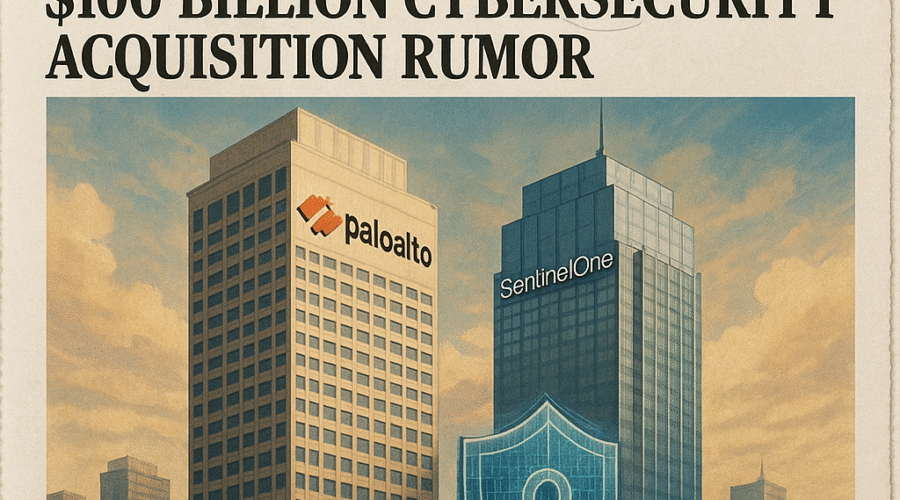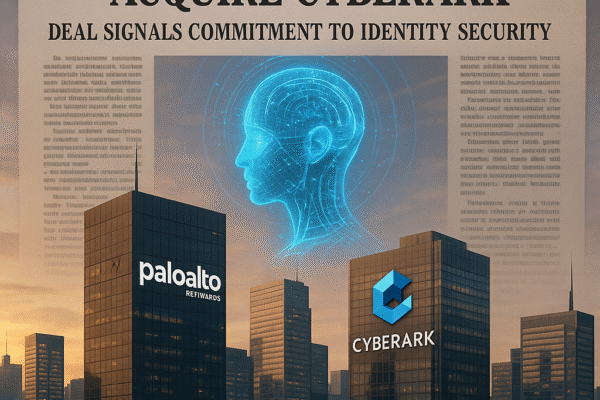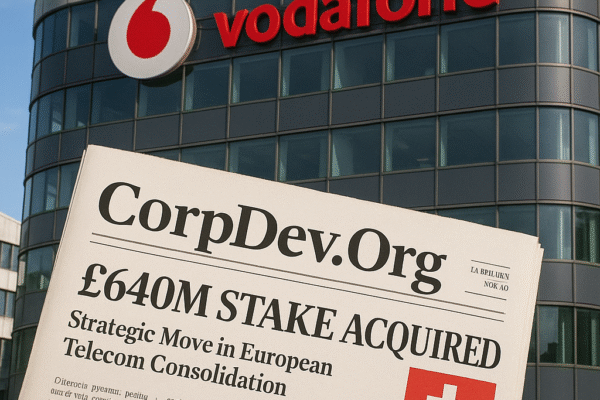The cybersecurity sector witnessed seismic speculation in July 2025 as multiple reports surfaced about Palo Alto Networks’ potential acquisition of SentinelOne for an estimated $7-10 billion. This analysis examines the strategic, financial, and market dimensions of the rumored transaction, which would represent Palo Alto’s largest acquisition to date and fundamentally reshape the endpoint security landscape. While Palo Alto Networks initially denied negotiations, conflicting reports from Israeli financial media and unusual trading patterns suggest deeper market forces at play. The deal’s viability hinges on Palo Alto’s ambition to dominate the $100 billion cybersecurity valuation threshold, SentinelOne’s discounted public valuation, and intensifying competition with CrowdStrike and Microsoft in the AI-driven security market.
💼 M&A / PE diligence in 24 hours? Yes, thanks to AI!
The Acquisition Timeline and Market Reaction
Rumor Genesis and Trading Volatility
Industry speculation began on July 21, 2025, when Israeli financial outlets Calcalist and Globes reported advanced negotiations between Palo Alto Networks and SentinelOne, citing anonymous industry sources[7][15]. The reports suggested a potential valuation between $7-10 billion for SentinelOne, representing a significant premium over its then-current $6.3 billion market capitalization[3][14]. Market reaction was immediate and pronounced: SentinelOne shares surged 15% intraday on July 21 before closing 10% higher on trading volume nearly seven times its 30-day average[7][14]. This volatility pattern continued throughout the week as contradictory statements emerged, with Palo Alto Networks telling CNBC there was “no truth” to the rumors while simultaneously adopting a “no comment” position to other outlets[10][14]. The trading patterns revealed deep market uncertainty, with options activity indicating both speculation about a premium buyout and hedging against deal collapse[9].
Historical Context of Acquisition Rumors
This marks at least the third acquisition rumor involving SentinelOne since its 2021 IPO. In 2023, reports surfaced about potential acquisition interest from Wiz, though discussions terminated due to “continued lack of execution against commitments” according to SentinelOne[2]. The current Palo Alto speculation emerges against a backdrop of major cybersecurity consolidation, including Google’s pending $32 billion acquisition of Wiz (approved by DOJ in 2025) and Palo Alto’s own recent $500 million acquisition of Protect AI[2][7]. Historical patterns reveal Palo Alto’s preference for smaller “tuck-in” acquisitions (17 deals since 2018 averaging $250 million), making this potential transaction a radical departure from CEO Nikesh Arora’s established M&A playbook[3][6].
Strategic Rationale for Palo Alto Networks
Endpoint Security Expansion
Acquiring SentinelOne would immediately bolster Palo Alto’s competitive position in the endpoint detection and response (EDR) market, where it currently trails CrowdStrike and Microsoft[7][14]. SentinelOne’s Singularity platform—featuring AI-powered behavioral analysis and automated threat response—would integrate with Palo Alto’s XSIAM security operations platform, creating a comprehensive threat detection ecosystem[1][2]. This alignment addresses Palo Alto’s historical gap in endpoint security, identified by analysts as a vulnerability against competitors with more complete platform offerings[6][14]. The acquisition would particularly enhance Palo Alto’s capabilities against ransomware and zero-day attacks, where SentinelOne’s technology has demonstrated industry-leading efficacy[4][9].
Accelerating the $100 Billion Vision
CEO Nikesh Arora has publicly targeted making Palo Alto Networks the first $100 billion cybersecurity company, stating in 2022: “I am convinced that we can, and I have publicly stated that we will be the first $100 billion cyber company”[8]. With Palo Alto’s market capitalization at $134 billion in July 2025, the SentinelOne acquisition would represent a strategic acceleration toward this goal by adding SentinelOne’s $664 million ARR (growing at 42% YoY) and 1,459 enterprise customers[4][9]. More significantly, the deal would position Palo Alto to capture more security operations center (SOC) budgets through SentinelOne’s extended detection and response (XDR) capabilities, a market projected to grow at 20% CAGR through 2028[6][14]. This expansion into SOC territory directly challenges Microsoft’s security operations dominance and CrowdStrike’s Falcon platform[14].
SentinelOne’s Position and Valuation Dynamics
Financial Performance and Market Pressures
SentinelOne presents a complex financial profile that makes acquisition timing strategically ambiguous. The company reported strong Q1 2025 results with $229 million revenue (22.9% YoY growth) and record 20% free cash flow margins[9]. However, it simultaneously revised full-year 2025 revenue guidance downward to $996 million-$1.1 billion from $1.01-$1.012 billion, citing “elongated sales cycles and deal slippage” in a challenging macroeconomic environment[7][9]. This revision continued a pattern of decelerating growth from its 2021 IPO peak, when it commanded a $9 billion valuation as the largest cybersecurity debut in history[7][14]. Despite trading 57% below IPO price, SentinelOne maintains robust fundamentals including $948 million annual recurring revenue (24% YoY growth) and leadership in AI-powered threat detection[4][9].
Valuation Discrepancies and Premium Analysis
The rumored $7-10 billion acquisition price represents a 11-58% premium over SentinelOne’s pre-rumor $6.3 billion market capitalization[3][14]. Analyst assessments reveal conflicting perspectives on valuation justification. ScotiaBank’s Patrick Colville questioned the timing, noting SentinelOne’s valuation “has remained largely steady over the past two years” without significant discounting[3]. Conversely, technical analysis suggests a GF Value of $28.93 per share (versus $19.58 pre-rumor) and average analyst target of $22.95, implying 10-64% upside potential without acquisition premium[9]. At $10 billion, the deal would value SentinelOne at approximately 10x forward revenue—aligning with Palo Alto’s own trading multiple but representing a 67% premium to CrowdStrike’s 6x revenue multiple[14].
Financial and Structural Considerations
Funding Mechanics and Balance Sheet Impact
A transaction of this magnitude would require innovative financing structures given Palo Alto’s historical preference for cash-and-stock deals. Analysts project three potential scenarios: an all-stock transaction (leveraging PANW’s premium valuation), a leveraged buyout with debt financing, or a hybrid structure with significant equity component[3][14]. Back-of-the-envelope calculations suggest a $10 billion all-stock deal would dilute existing Palo Alto shareholders by approximately 7%, while a cash transaction could consume nearly 30% of Palo Alto’s $34 billion cash reserves[3][14]. More significantly, integration costs could reduce Palo Alto’s free cash flow margin by 200 basis points according to ScotiaBank analysis, potentially triggering investor concern given Palo Alto’s recent path to sustained profitability[3][8].
Comparative Acquisition Strategy
Palo Alto’s M&A history reveals a clear pattern of “tuck-in” acquisitions focused on technology integration rather than market transformation. The company has completed 17 acquisitions since 2018 totaling $4.5 billion, with an average deal size of $265 million[3][6]. The largest prior acquisition—Demisto for $560 million in 2019—pales against the SentinelOne scale[6]. This departure from established strategy raises questions about integration complexity, particularly given SentinelOne’s 2,400 employees and established sales channels[7][14]. Historical precedents suggest Palo Alto excels at integrating engineering talent but faces challenges merging sales organizations, as evidenced by the 18-24 month integration timeline for Cortex XDR[6].
Industry Context and Competitive Implications
Cybersecurity Consolidation Wave
The rumored acquisition occurs amid unprecedented consolidation in the cybersecurity sector. Google’s $32 billion acquisition of Wiz (expected to close in 2026) and Cisco’s $28 billion Splunk purchase have established a new scale for platform-focused security deals[2][14]. Private equity firms like Thoma Bravo have simultaneously accelerated roll-up strategies, acquiring multiple mid-tier security vendors to build comprehensive platforms[14]. This consolidation reflects enterprise demand for consolidated security platforms—Gartner estimates 65% of enterprises will consolidate security vendors by 2026, up from 15% in 2021[6]. For Palo Alto, acquiring SentinelOne represents both offensive positioning against Microsoft’s integrated security suite and defensive maneuvering against CrowdStrike’s expanding platform capabilities[1][14].
Endpoint Security Market Dynamics
The EDR/XDR market where SentinelOne competes features intense rivalry among four major players: CrowdStrike (market leader), Microsoft (integrated with Azure), SentinelOne, and Palo Alto Networks[14]. A combined Palo Alto-SentinelOne entity would command approximately 18% market share—still trailing CrowdStrike’s 25% but surpassing Microsoft’s 15% in pure-play security[14]. More significantly, the acquisition would accelerate the convergence of network security (Palo Alto’s core strength) and endpoint protection (SentinelOne’s specialty), creating a unified platform capable of automated threat response across infrastructure layers[1][7]. Industry analysts note this could pressure smaller pure-play vendors while forcing Microsoft to accelerate security integration within its enterprise suites[14].
Execution Risks and Regulatory Considerations
Integration Challenges
Successfully merging SentinelOne’s AI-driven endpoint technology with Palo Alto’s platform-centric architecture presents substantial technical and operational hurdles. SentinelOne’s Singularity platform operates on a fundamentally different data architecture than Palo Alto’s Cortex XDR, requiring complex API integration that could take 18-36 months to fully implement[1][6]. Cultural integration poses additional risks—SentinelOne’s Israeli engineering culture (with significant R&D presence in Tel Aviv) differs from Palo Alto’s California-centric development approach, though Palo Alto has successfully integrated multiple Israeli acquisitions including Demisto and Dig Security[15]. Sales channel conflict represents perhaps the most immediate challenge, as both companies maintain competing partner programs and enterprise sales teams that would require careful consolidation[3][14].
Regulatory and Antitrust Scrutiny
At $10 billion, the transaction would likely trigger rigorous antitrust review given the combined entity’s strength in multiple security segments. The Federal Trade Commission (FTC) has recently intensified scrutiny of cybersecurity mergers, as evidenced by the extended review period for Google’s Wiz acquisition[2]. Particular attention would focus on the combined company’s 35% share in the Security Information and Event Management
Sources
https://www.ainvest.com/news/palo-alto-networks-eyes-100-billion-sentinelone-acquisition-2507/, https://www.sdxcentral.com/news/palo-alto-networks-in-talks-to-acquire-sentinelone-report/, https://www.crn.com/news/security/2025/sentinelone-valuation-raises-questions-about-reported-palo-alto-networks-m-a-talks-analyst, https://www.datagravity.dev/p/start-up-nation-an-incomplete-history, https://www.themiddlemarket.com/latest-news/palo-alto-networks-reportedly-in-talks-to-acquire-sentinelone, https://rakgarg.substack.com/p/the-race-to-100b-the-palo-alto-networks, https://www.calcalistech.com/ctechnews/article/kfqzwg5wr, https://www.calcalistech.com/ctechnews/article/byidvs00vi, https://www.ainvest.com/news/sentinelone-buyout-drama-navigating-volatility-high-stakes-cybersecurity-landscape-2507/, https://www.marketscreener.com/news/palo-alto-says-no-truth-to-rumor-of-sentinelone-takeover-talks-ce7c5cddda8ef027, https://finimize.com/content/s-asset-snapshot, https://cyberir.mit.edu/site/race-100b-palo-alto-networks-story/, https://www.tradingview.com/news/reuters.com,2025:newsml_L4N3TI1B4:0-sentinelone-rallies-on-report-of-palo-alto-mulling-7-billion-buyout/, https://www.calcalistech.com/ctechnews/article/ryj3x11r8gg, https://en.globes.co.il/en/article-palo-alto-networks-mulls-buying-israeli-co-sentinelone-1001516657





